Winds of Change
Early Climate Science
People have been interested in the weather for centuries, but scientists have only had the tools to study climate for about 200 years. The idea that the global climate has changed over millennia emerged about 170 years ago from research by geologists and paleontologists. Examination of fossil remains by early paleontologists led them to realize that animals they thought of as warm-climate creatures had once lived in northern Europe. They debated whether the climate of Europe had been different, or whether the fossil animals had adapted to live in a colder environment.
Geologists who studied glaciers and their activity in shaping the Alps settled the question. In the late 1830s, Louis Agassiz and other geologists discovered that much of Europe had once been covered by glaciers. This discovery led to a realization that earth’s climate was much warmer in the nineteenth century than it had been in the past. Agassiz’s work on the Ice Age made him a celebrity and launched scientific interest in paleoclimatology.
Although Agassiz and his colleagues knew the climate could change, they did not understand how or why. A group of physicists in the late nineteenth century supplied the next pieces of the puzzle. Joseph Fourier and John Tyndall conducted work on the greenhouse effect, explaining how gases in the atmosphere both trap and conducts heat from the sun. In 1896, Svante Arrhenius made the connection between human activity and the greenhouse effect, calculating that doubling the carbon dioxide in the atmosphere through industrial activity would raise the global temperature by about 4 degrees Celsius.
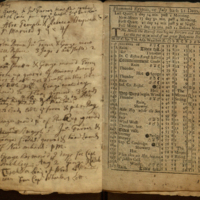
An almanack for the year of our Lord… calculated for and fitted to the meridian of Boston in New-England … Boston : Printed by B. Green …, 1721. Rare AY201.B7 A619 1721
Detailed meteorological recordkeeping and forecasting only date from the middle of the nineteenth century. Before that, people depended on handwritten records and their own memories to keep track of the weather from season to season. Historians therefore have to use a wide variety of resources to track the variations in climate over the centuries. Handwritten records in almanacs and journals, advice in agricultural manuals, newspaper reports, and observations in ships’ logbooks are all valuable sources of information for historical climatologists.
Almanacs are a useful source of data for historical climatologists, not because of their weather forecasts, but because people often used them to record daily or weekly observations. Their early owners interleaved them with blank paper and used them to write notes on the weather, the progress of their fields and animals, and the happenings of their daily lives.
This almanac, intended for use near Boston, contains numerous notes about the weather, as compared against what the writer considered normal. For May 15, he or she recorded “this day [& not before] the Apple trees, generally, white with Blossoms.” On March 9, he or she noted “A violent shower of snow very damp but as great a quantity fell as at any one time in this year.” The weather in August was likely warm and dry: perfect for mowing hay. The writer recorded mowing throughout that month.
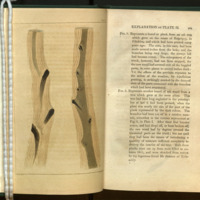
Walter Nicol (1769-1811). The Planter’s Kalendar; or, The Nurseryman’s & Forester’s Guide… Edinburgh: Printed by D. Willison for A. Constable and Co., 1812. Rare SD391.N63 1812
Read online
Agricultural manuals like this one are another important source of historical climate data. They often provide a sense of the temperature ranges and types of precipitation the farmer could expect for each season of the year. This manual on planting trees was written for the climate of Scotland. For the month of February, the author notes,
In this climate, and particularly in Scotland, we can depend with certainty on having abundant rains, at short intervals, during this month and March, and even April. But, beyond that till June, we not unfrequently have severe parching droughts.
Today, according to the Royal Botanic Garden in Edinburgh, there is considerably more precipitation in May and June than in February or April. Was Nicol’s observation wrong, or has the climate changed in the last 200 years? That is one question scientists must consider when using historical data.
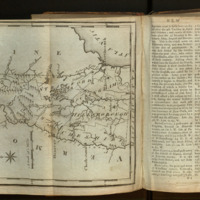
Henry Joseph Scott. The United States Gazetteer: Containing an Authentic Description of the Several States… Philadelphia: Printed by F. and R. Bailey, 1795. Rare E154.S42 1795
This gazetteer was the first book of maps published about the United States. For each state, Scott includes a general description, including data about the climate. It is uncertain where Scott gets his data, but he does include temperature readings. The following is from his description of Portsmouth, New Hampshire:
In July and August the sun becomes considerably warm. The greatest degree of heat observed at Portsmouth, according to Farenheit’s [sic] thermometer, was 90 above 0, and of cold 8 below 0. Light frosts have been known in every month of the year except July.
One of the difficulties of working with historical measurements is that they may have been unreliable. According to the weather station at Portsmouth’s Pease Air Force Base, temperatures over 90 degrees have been recorded nearly every year in July and August since 1960. Contrary to Scott’s data, over the period from 1960 to 2014, only three frosts were recorded in the summer months.
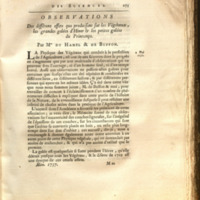
Henri-Louis Duhamel du Monceau (1700-1782) and Georges-Louis LeClerc de Buffon (1707-1788). “Observations des différents effets que produisent sur les végétaux les grandes gelées d'hiver et les petites gelées du printemps.” Mémoires de l'Académie royale des science. Paris: Gauthier-Villars [etc.], 1737, pp. 273-298. Rare Q46 .A13
Tree rings are an important source of data about past climates. Each year, as trees grow, they add a layer of tissue, which shows up as a ring in a cross section. Rings are usually wide in good growing seasons and narrow in less favorable conditions.
Although people have known that trees have rings for millennia, Duhamel and LeClerc were among the first to discover that tree rings could be studied scientifically. In this paper, they identified a dark ring in French trees that corresponded with the Great Winter of 1709, a particularly cold winter that still perplexes scientists with its severity. For decades after this discovery, botanists used this dark ring as a reference point for dating.
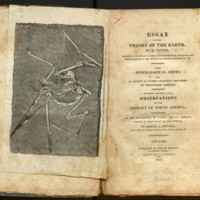
Georges Cuvier (1769-1832). Essay on the Theory of the Earth. New York: Kirk & Mercein, 1818. Rare 550 C988e 1818
Read online
In order to study climate change, some scientists look to stratigraphy and sediment analysis. The originator of these techniques, Georges Cuvier, founded the modern science of paleontology and was among the first to recognize that the earth’s surface is made up of layers, or strata, from successive time periods.
Cuvier believed that fossil animals were not related to modern ones, instead proposing that natural catastrophes such as sudden drops in temperature led to numerous mass extinctions throughout earth’s history. Although Cuvier’s catastrophism was discounted by nineteenth-century geologists, current interest in climate change has led to a resurgence of interest in the concept of mass extinction.
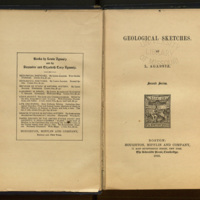
Louis Agassiz (1807-1873). Geological Sketches. Boston and New York: Houghton, Mifflin and company, [1875]. MU Depository 550.4 Ag1g
Read online
Louis Agassiz was among the first scientists to suggest that the earth has been subject to climate change in the past. In 1840, in his Etudes sur les glaciers, he presented geological evidence that much of Europe had been covered by a vast sheet of ice thousands of years ago.
Agassiz was Cuvier’s student, and he shared his interest in geology and anatomy. Agassiz proposed that the Ice Age was responsible for one of Cuvier’s mass extinctions, wiping out “tropical” mammals such as the mastodons Cuvier found in fossil remains. However, he thought the shift in climate had been extremely sudden, happening over a matter of days or weeks.
Although Agassiz may not have had all the details right, his hunch that the earth had once been colder was correct. His ideas also laid the groundwork for the concept of a shifting global climate.
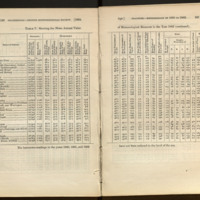
James Glaisher (1809-1903). On the meteorology of England for the years 1858 to 1862 : and the combination of the results with those of the years 1855, 1856, and 1857. [London]: [British Meteorological Society], [1864]. Rare QC989.E5 G53 1864
Reliable scientific climate records date from the middle of the nineteenth century. These records exist thanks to scientists like James Glaisher, who was a pioneer in the study of climate. Glaisher worked for the Royal Observatory in Greenwich and was a founding member of the British Meteorological Society, which aimed to determine “the laws of climate and of meteorological phenomena in general.”
Glaisher made many hot air balloon ascents between 1862 and 1866 to measure the temperature and humidity of the atmosphere. This volume contains his observations from one of his trips, as well as compiled climate data from 1855 to 1862.
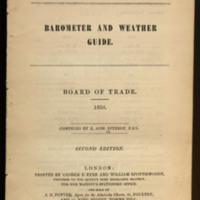
Robert Fitzroy (1805-1865). Barometer and Weather Guide. London: Printed by George E. Eyre and William Spottiswoode, for Her Majesty's Stationery Office, 1858. Rare QC885 .F57 1858
Read online
Vice-Admiral Robert Fitzroy invented a concept most of us benefit from every day: the scientific weather forecast. As a naval officer and scientist, Fitzroy maintained a lifelong interest in measuring and predicting the weather. After he retired from active service, he was asked to become the Meteorological Statist to the Board of Trade, where he provided ships with instruments and instructions for taking accurate daily readings. He also founded a network of land stations that relayed daily weather data by telegraph.
Fitzroy’s focus on collecting data and identifying long-range trends meant that he was able to make accurate weather predictions. His gale warnings saved the lives of countless sailors and fishermen, and the data he recorded is still available to scientists today.

John Tyndall (1820-1893). Contributions to molecular physics in the domain of radiant heat. New York: D. Appleton, 1888. MU Depository 539 T97
Read online
While Joseph Fourier may have come up with the concept of the greenhouse effect, John Tyndall established its experimental basis. In 1863, he introduced the idea in a public lecture, the text of which is printed here.
Tyndall tested various gases to determine their ability to absorb heat. He found that nitrogen and oxygen, the main components of the earth’s atmosphere, readily transmit heat. He also showed that water vapor and carbon dioxide trap heat, storing it in the atmosphere.
Using the relatively new idea of ice ages pioneered by Agassiz and others, Tyndall suggested that changes in the atmosphere could explain changes in climate over time.

Svante Arrhenius (1859-1927). Worlds in the Making: The Evolution of the Universe. New York; London: Harper, 1908. MU Depository 113 Ar69
Read online
Svante Arrhenius was the first scientist to quantify how levels of carbon dioxide in the atmosphere could affect the surface temperature of the earth. Like Tyndall and Fourier, Arrhenius used the metaphor of a greenhouse to explain how the atmosphere traps heat. He predicted that doubling the CO2 in the atmosphere would raise the average temperature by about 4 degrees Celsius, a reasonably close estimate by today’s standards. He was also the first to link human activity to the amount of carbon dioxide in the atmosphere.
It is interesting to note that Arrhenius did not see this warming effect as a cause for concern. Instead, he thought it would keep the world safe from another ice age.
Is it probable that we shall in the coming geological ages be visited by a new ice period that will drive us from our temperate countries into the hotter climates of Africa? There does not appear to be much ground for such an apprehension. The enormous combustion of coal by our industrial establishments suffices to increase the percentage of carbon dioxide in the air to a perceptible degree.